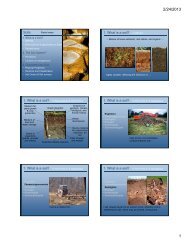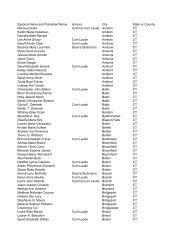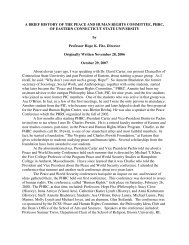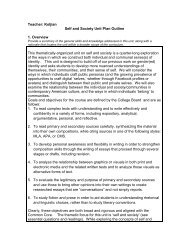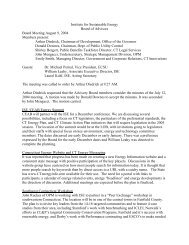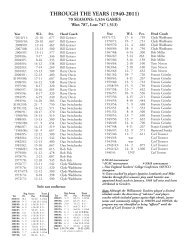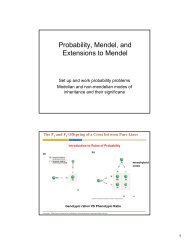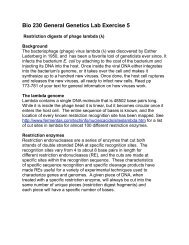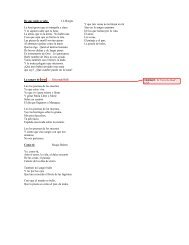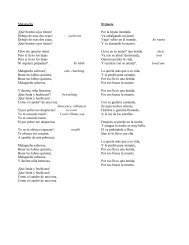Rustoleum bright coat metallic finish, aluminum 7715
Rustoleum bright coat metallic finish, aluminum 7715
Rustoleum bright coat metallic finish, aluminum 7715
You also want an ePaper? Increase the reach of your titles
YUMPU automatically turns print PDFs into web optimized ePapers that Google loves.
Material Safety Data<br />
Sheet<br />
Section 1 - Chemical Product / Company Information<br />
Product Name:<br />
Identification<br />
Number:<br />
Stops Rust Brite Coat Metallic Color<br />
Aerosol<br />
7710830, <strong>7715</strong>830, 7718830,<br />
V7710830, V<strong>7715</strong>830<br />
Product Use/Class: Metallic/Aerosol<br />
Supplier: Rust -Oleum Corporation<br />
11 Hawthorn Parkway<br />
Vernon Hills, IL 60061<br />
USA<br />
Preparer: Department, Regulatory<br />
*** Emergency Overview ***: Contents Under Pressure. Harmful if inhaled. May affect the brain or nervous system<br />
causing dizziness, headache or nausea. Vapors may cause flash fire or explosion. Extremely flammable liquid and<br />
vapor. Harmful if swallowed.<br />
Effects Of Overexposure - Eye Contact: Causes eye irritation.<br />
Revision Date: 05/06/2003<br />
Section 2 - Composition / Information On Ingredients<br />
24 Hour Assistance:<br />
1-847-367-7700<br />
Rust-Oleum Corp.<br />
www.rustoleum.com<br />
Manufacturer: Rust -Oleum Corporation<br />
11 Hawthorn Parkway<br />
Vernon Hills, IL 60061<br />
USA<br />
Chemical Name CAS Number Weight % Less ACGIH TLV-TWA<br />
Than<br />
ACGIH TLV-STEL OSHA PEL-TWA OSHA PEL-CEILING<br />
Toluene 108-88-3 60.0 50 PPM N.E. 200 PPM 300 PPM<br />
Liquified Petroleum Gas 68476-86 -7 40.0 1000 PPM N.E. 1000 PPM N.E.<br />
Hydrocarbon Resin PROPRIETARY 25.0 100 ppm N.E. 100 ppm N.E.<br />
Hydrotreated Light Distillate 64742-47 -8 15.0 N.E. N.E. N.E. N.E.<br />
Xylene 1330-20-7 15.0 100 PPM 150 PPM 100 PPM N.E.<br />
Acetone 67-64-1 15.0 500 PPM 750 PPM 750 PPM N.E.<br />
Copper Compounds NOT<br />
SPECIFIED<br />
10.0 1 mg/m3-dust 2 mg/m3 1 mg/m3-dust N.E.<br />
Resin Solution PROPRIETARY 10.0 N.E. N.E. N.E. N.E.<br />
Aluminum 7429-90-5 10.0<br />
Ethylbenzene 100-41-4 5.0 100 PPM 125 PPM 100 PPM N.E.<br />
Stoddard Solvents 8052-41-3 5.0 100 PPM N.E. 500 PPM N.E.<br />
Section 3 - Hazards Identification<br />
Effects Of Overexposure - Skin Contact: Prolonged or repeated contact may cause skin irritation. Substance may<br />
cause slight skin irritation.<br />
Effects Of Overexposure - Inhalation: High vapor concentrations are irritating to the eyes, nose, throat and lungs.<br />
Avoid breathing vapors or mists. High gas, vapor, mist or dust concentrations may be harmful if inhaled. Harmful if<br />
inhaled.<br />
Effects Of Overexposure - Ingestion: Aspiration hazard if swallowed; can enter lungs and cause damage.<br />
Substance may be harmful if swallowed.<br />
Page 1 of 6
Effects Of Overexposure - Chronic Hazards: IARC lists Ethylbenzene as a possible human carcinogen (group 2B).<br />
May cause central nervous system disorder (e,g.,narcosis involving a loss of coordination, weakness, fatigue,<br />
mental confusion, and blurred vision) and/or damage. Reports have associated repeated and prolonged<br />
occupational overexposure to solvents with permanent brain and nervous system damage. Overexposure to xylene<br />
in laboratory animals has been associated with liver abnormalities, kidney, lung, spleen, eye and blood damage as<br />
well as reproductive disorders. Effects in humans, due to chronic overexposure, have included liver, cardiac<br />
abnormalities and nervous system damage. Overexposure to toluene in laboratory animals has been associated<br />
with liver abnormalities, kidney, lung and spleen damage. Effects in humans have included liver and cardiac<br />
abnormalities.<br />
Primary Route(s) Of Entry: Skin Contact, Skin Absorption, Inhalation, Eye Contact<br />
Section 4 - First Aid Measures<br />
First Aid - Eye Contact: Hold eyelids apart and flush with plenty of water for at least 15 minutes. Get medical<br />
attention.<br />
First Aid - Skin Contact: Wash with soap and water. Get medical attention if irritation develops or persists.<br />
First Aid - Inhalation: If you experience difficulty in breathing, leave the area to obtain fresh air. If continued<br />
difficulty is experienced, get medical assistance immediately.<br />
First Aid - Ingestion: Aspiration hazard: Do not induce vomiting or give anything by mouth because this material<br />
can enter the lungs and cause severe lung damage. Get immediate medical attention.<br />
Section 5 - Fire Fighting Measures<br />
Flash Point: -156 F LOWER EXPLOSIVE LIMIT: 0.9 %<br />
(Setaflash) UPPER EXPLOSIVE LIMIT : 9.5 %<br />
Extinguishing Media: Dry Chemical, Foam, Water Fog<br />
Unusual Fire And Explosion Hazards: Keep containers tightly closed. Vapors can travel to a source of ignition and<br />
flash back. Vapors may form explosive mixtures with air. FLASH POINT IS LESS THAN 20 DEG. F. - EXTREMELY<br />
FLAMMABLE LIQUID AND VAPOR! Closed containers may explode when exposed to extreme heat. Water spray<br />
may be ineffective. Perforation of the pressurized container may cause bursting of the can. Isolate from heat,<br />
electrical equipment, sparks and open flame.<br />
Special Firefighting Procedures: Evacuate area and fight fire from a safe distance.<br />
Section 6 - Accidental Release Measures<br />
Steps To Be Taken If Material Is Released Or Spilled: Dispose of according to local, state (provincial) and federal<br />
regulations. Do not incinerate closed containers. Remove all sources of ignition, ventilate area and remove with<br />
inert absorbent and non-sparking tools. Contain spilled liquid with sand or earth. DO NOT use combustible<br />
materials such as sawdust.<br />
Section 7 - Handling And Storage<br />
Page 2 of 6<br />
Handling: Wash thoroughly after handling. Wash hands before eating. Use only in a well -ventilated area. Avoid<br />
breathing vapor or mist. Follow all MSDS/label precautions even after container is emptied because it may retain<br />
product residues.
Storage: Keep containers tightly closed. Isolate from heat, electrical equipment, sparks and open flame. Do not<br />
store above 120 degrees F. Store large quantities in buildings designed and protected for storage of NFPA Class I<br />
flammable liquids. Contents under pressure. Do not expose to heat or store above 120 degrees F.<br />
Section 8 - Exposure Controls / Personal Protection<br />
Engineering Controls: Prevent build-up of vapors by opening all doors and windows to achieve cross -ventilation.<br />
Use process enclosures, local exhaust ventilation, or other engineering controls to control airborne levels below<br />
recommended exposure limits. Use explosion-proof ventilation equipment.<br />
Respiratory Protection: A NIOSH/MSHA approved air purifying respirator with an organic vapor cartridge or canister<br />
may be permissible under certain circumstances where airborne concentrations are expected to exceed exposure<br />
limits.<br />
Protection provided by air purifying respirators is limited. Use a positive pressure air supplied respirator if there is<br />
any potential for an uncontrolled release, exposure levels are not known, or any other circumstances where air<br />
purifying respirators may not provide adequate protection. A respiratory protection program that meets OSHA<br />
1910.134 and ANSI Z88.2 requirements must be followed whenever workplace conditions warrant a respirator's<br />
use.<br />
Skin Protection: Nitrile or Neoprene gloves may afford adequate skin protection. Use impervious gloves to prevent<br />
skin contact and absorption of this material through the skin.<br />
Eye Protection: Use safety eyewear designed to protect against splash of liquids.<br />
Other protective equipment: Refer to safety supervisor or industrial hygienist for further information regarding<br />
personal protective equipment and its application.<br />
Hygienic Practices: Wash thoroughly with soap and water before eating, drinking or smoking.<br />
Section 9 - Physical And Chemical Properties<br />
Boiling Range: -34 - 232 F Vapor Density: Heavier than air<br />
Odor: Solvent Like Odor Threshold: ND<br />
Appearance: Liquid Evaporation Rate: Faster than Ether<br />
Solubility in H2O: Slight<br />
Freeze Point: ND Specific Gravity:<br />
Vapor Pressure: PH: NE<br />
Physical State: Liquid<br />
(See section 16 for abbreviation legend)<br />
Section 10 - Stability And Reactivity<br />
Conditions To Avoid: Avoid all possible sources of ignition. Avoid temperatures above 120 degrees F.<br />
Incompatibility: Incompatible with strong oxidizing agents, strong acids and strong alkalies.<br />
Hazardous Decomposition: When heated to decomposition it emits acrid smoke and irritating fumes. By open<br />
flame, carbon monoxide and carbon dioxide.<br />
Hazardous Polymerization: Will not occur under normal conditions.<br />
Page 3 of 6
Stability: This product is stable under normal storage conditions.<br />
Section 11 - Toxicological Information<br />
Product LD50: ND Product LC50: ND<br />
Chemical Name LD50 LC50<br />
Toluene N.D. N.D.<br />
Liquified Petroleum Gas N.E. N.E.<br />
Hydrocarbon Resin<br />
Hydrotreated Light Distillate<br />
>4.2 G/KG RAT N.D.<br />
Xylene N.D. N.D.<br />
Acetone<br />
Copper Compounds<br />
N.D. N.D.<br />
Resin Solution<br />
Aluminum<br />
>5000 MG/M3 N.D.<br />
Ethylbenzene 3500 mg/kg<br />
(ORAL, RAT)<br />
N.D.<br />
Stoddard Solvents N.D. N.D.<br />
Section 12 - Ecological Information<br />
Ecological Information: Product is a mixture of listed components.<br />
Section 13 - Disposal Information<br />
Disposal Information: Dispose of material in accordance to local, state and federal regulations and ordinances. Do<br />
not allow to enter storm drains or sewer systems.<br />
Section 14 - Transportation Information<br />
DOT Proper Shipping Name: Aerosol Packing Group: ---<br />
DOT Technical Name: --- Hazard Subclass: 1<br />
DOT Hazard Class: 2 Resp. Guide Page: 126<br />
DOT UN/NA Number: UN 1950<br />
Section 15 - Regulatory Information<br />
CERCLA - SARA Hazard Category<br />
This product has been reviewed according to the EPA "Hazard Categories" promulgated under Sections 311and<br />
312 of the Superfund Amendment and Reauthorization Act of 1986 (SARA Title III) and is considered, under<br />
applicable definitions, to meet the following categories:<br />
IMMEDIATE HEALTH HAZARD, CHRONIC HEALTH HAZARD, FIRE HAZARD<br />
Page 4 of 6
SARA Section 313:<br />
Listed below are the substances (if any) contained in this product that are subject to the reporting requirements of<br />
Section 313 of Title III of the Superfund Amendment and Reauthorization Act of 1986 and 40 CFR part 372:<br />
Chemical Name CAS Number<br />
Toluene 108-88-3<br />
Hydrocarbon Resin PROPRIETARY<br />
Xylene 1330-20-7<br />
Copper Compounds NOT SPECIFIED<br />
Resin Solution PROPRIETARY<br />
Ethylbenzene 100-41-4<br />
Toxic Substances Control Act:<br />
Listed below are the substances (if any) contained in this product that are subject to the reporting requirements of<br />
TSCA 12(B) if exported from the United States:<br />
None known<br />
U.S. State Regulations: As follows -<br />
New Jersey Right-to-Know:<br />
The following materials are non-hazardous, but are among the top five components in this product.<br />
Chemical Name CAS Number<br />
ALKYD RESIN PROPRIETARY<br />
Pennsylvania Right-to-Know:<br />
The following non-hazardous ingredients are present in the product at greater than 3%.<br />
Chemical Name CAS Number<br />
ALKYD RESIN PROPRIETARY<br />
California Proposition 65:<br />
Warning: The following ingredients present in the product are known to the state of California to cause Cancer:<br />
Chemical Name CAS Number<br />
Benzene 71-43-2<br />
Acetaldehyde 75-07-0<br />
Formaldehyde 50-00-0<br />
Warning: The following ingredients present in the product are known to the state of California to cause birth defects,<br />
or other reproductive hazards.<br />
Chemical Name CAS Number<br />
Toluene 108-88-3<br />
Benzene 71-43-2<br />
Ethylene Glycol Monoethyl Ether 110-80-5<br />
Page 5 of 6
International Regulations: As follows -<br />
CANADIAN WHMIS:<br />
This MSDS has been prepared in compliance with Controlled Product Regulations except for the use of the 16<br />
headings.<br />
CANADIAN WHMIS CLASS: AB5 D2A D2B<br />
Section 16 - Other Information<br />
HMIS Ratings:<br />
Health: 2* Flammability: 4 Reactivity: 0 Personal Protection: X<br />
VOLATILE ORGANIC COMPOUNDS, g/l: NA<br />
REASON FOR REVISION:<br />
Legend: N.A. - Not Applicable, N.E. - Not Established, N.D. - Not Determined<br />
The information contained on this MSDS has been checked and should be accurate. However, it is the<br />
responsibility of the user to comply with all Federal, State, and Local laws and regulations.<br />
Page 6 of 6



